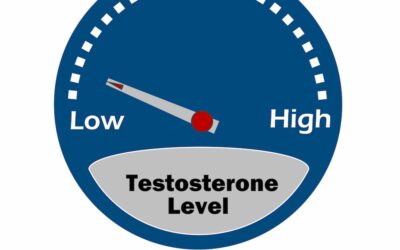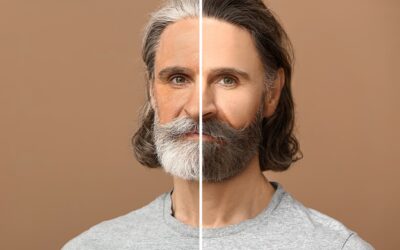Testosterone is the primary secreted androgen hormone in men.1 It plays a crucial role in the development, growth, and various physiologic functions throughout the human lifecycle.1 About 95% of testosterone is produced in the testicles in men, and the remaining 5% is produced in adrenal glands.2 A specialized type of cells in the testes known as Leydig cells synthesizes testosterone .2 The level of testosterone is usually higher in men than women throughout all stages of life. Maintaining testosterone level within normal ranges is essential for maintaining bone density, appropriate fat distribution, muscle mass and strength, facial and body hair, production of red blood cells, sex drive, and sperm production.1
Average Testosterone Levels by Age
The synthesis and secretion of testosterone start in the womb during the first trimester.1 By the second trimester, the level of testosterone reaches about 250 ng/dL, close to the level of testosterone in mid-puberty.1 By the end of the second trimester, the level of testosterone falls, however, it rises again to about 250 ng/dL by birth. Several studies have shown that fetal testosterone plays a crucial role in brain development and may have a lasting impact on brain function and behavior.1 At this stage, testosterone also plays an essential role in the development of reproductive organs. Within a few days of birth, the level of testosterone falls, and it peaks again to 250 ng/dL at 2 to 3 months after birth. After about six months of birth, the level drops to about 50 ng/dL, and it remains at this low level until puberty.1 Testosterone levels peak during puberty, between 12 to 17 years of age. In young men, the level of testosterone ranges between 300-800 ng/dL compared to 30-50 ng/dL in women.1 The rise in the level of testosterone in men by puberty contributes to the body changes that occur at this stage of life. Testosterone stimulates the growth of bones and muscles, the production of red blood cells, the enlargement of the voice box, the growth of facial and body hair, the enlargement of the genitals, and the awakening of sexual function and reproductive capacity.1 In most young men, testosterone production reaches its peak at about 17 years of age, and its levels remain high during the next two to three decades. Healthy young men produce about six milligrams of testosterone a day.2
What Happens to Testosterone As We Age?
As men age, the level of testosterone gradually declines by about 1% a year.1 Testosterone decline in most men usually begins at about 40 years of age.1 Unlike the sudden drop in reproductive hormones that women experience at menopause, the testosterone decline in men is gradual. By the age of 70, the average testosterone production in men is 30% below its peak.2 However, testosterone levels remain within the normal range in at least 75% of older men, which is why many men can have children throughout their life.2
The decline in the testosterone level as we age is due to changes in the body’s physiology and body ability to control and regulate testosterone production.3 Additionally, the reduction in the number of cells that synthesize and secrete testosterone reduces its blood level.3 In men older than 65, the decline in testosterone level below 280 ng/dL, which is accompanied by specific symptoms,s is known as hypogonadism.3 The decline in testosterone level contributes to the symptoms associated with aging, such as reduced libido, vitality, erectile dysfunction, diminished muscle mass and bone density, depression, and anemia.2 Some reports indicate that the number of men with low testosterone levels increases from 12% to 49% between the ages of 50 and 80.4 In most of these cases, the serum testosterone concentrations are close to the lower limit of the normal range.4 Interestingly, the prevalence of hypogonadism, which involves low testosterone levels plus specific symptoms, among these individuals is even lower (~2%). Determining whether the benefit of testosterone therapy outweighs the risk remains unclear.4
How Do I Measure Testosterone?
The first step to determine whether a man has low testosterone is to measure the total blood testosterone level. A “total” testosterone lab test measures free testosterone and the amount of testosterone bound to the proteins albumin and sex hormone-binding globulin (SHBG).5 The free and albumin-bound testosterone is the biologically active components in the body. However, accurate assessment of testosterone levels can be complicated due to several factors.5 Testosterone secretion fluctuates and changes throughout the day with the highest levels in the morning. The blood is usually drawn between 7, and 10 am to obtain the most accurate results. The clinician should compare the results to standard values to determine if the testosterone levels are within the normal ranges.5 In the general population of men, the level of testosterone usually ranges between 270 ng/dL to 1070 ng/dL. Due to the variability of testosterone levels throughout the day and from day to day, repeated measurements might be needed, especially if the results were very low or very high.5
What is a Testosterone Blood Test or Panel?
If the testosterone level was found to be below 270 ng/dL, would this indicate low testosterone? The answer is complicated. There is no general agreement regarding the threshold that confirms a low testosterone level.5 The diagnosis of low testosterone is usually based on the test results combined with the presence of the known symptoms of low testosterone.5 Testosterone exists in the blood in 3 different forms with varying biological activity.5 Only about 1 to 3% of the total testosterone is in a free biologically active way.5 Nearly half of the total testosterone is loosely bound to an abundant blood protein known as albumin and is relatively biologically active. However, about 40-70% of testosterone is tightly bound to the protein SHBG and is biologically inactive.5 The binding of testosterone to these proteins in the blood facilitates testosterone transport in the blood and distribution throughout the body. Therefore, to accurately diagnose testosterone deficiency, it is essential to work with an experienced clinician who has a good understanding of testosterone level measurement and the clinical symptoms associated with low testosterone. These symptoms may include low libido, erectile dysfunction, low sperm count, loss of body hair, and hot flashes.5
How Can I Improve My Testosterone Levels Naturally?
Can you boost testosterone levels naturally? There are several drug-free strategies to increase testosterone levels.6 Studies have shown that about 65% of patients with low testosterone levels have diabetes, metabolic syndrome, and obesity.6 Regular exercise and a healthy diet have been shown to increase serum testosterone levels.6 Additionally, in men who don’t exercise, decreased weight is also associated with a significant increase in testosterone levels.6 Incorporating lifestyle changes that include diet and exercise represents a relatively drug-free approach to treating low testosterone and should be recommended as a viable strategy, especially for overweight men.6 Interestingly, emerging evidence points out that individuals who prefer western-style food which includes bread and pastries, dairy products, and desserts, eating out and eating fewer homemade foods, such as noodles, and dark green vegetables, are more likely to have an unhealthy body composition, such as increased visceral fat and decreased skeletal muscle mass, and low serum total testosterone levels. These individuals are most likely to develop hypogonadism.7 However, randomized controlled trials are needed to confirm that an improvement in dietary choices can improve testosterone levels and reduce hypogonadism.7 Another emerging paradigm is the gut’s impact on testosterone levels. Recent studies indicate that the type and composition of microbial communities living in the gut can influence the level of sex hormones in men and women.8 The data suggest that the more diverse the bacterial communities, the higher the level of the sex hormones in the blood. Further studies are needed to identify novel strategies to modify testosterone level by modulating the gut microbiome.8
Supplements that are marketed as “natural testosterone boosters “are typically not regulated by the FDA and may have risks due to the variability in the content of the active ingredients.6 Additionally, certain active ingredients may interfere with prescribed medications, which can be problematic, especially in older men who use several prescription drugs.6
Moreover, the quality and duration of sleep have been linked to the level of testosterone.6 A recent study demonstrated that men with obstructive sleep apnea who were treated for their sleep condition experienced a significant increase in testosterone levels.6 Additionally, the duration and timing of sleep may impact testosterone.6 Sleep deprivation has been associated with a 10% to 15% reduction in testosterone.6 Therefore, men with poor sleep habits may improve their testosterone levels by restructuring their sleep schedules and ensuring that sleep duration and timing are appropriate.6
Testosterone level is also affected by stress.6 Studies have shown that the rise in a stress hormone, cortisol, disrupts testosterone-secreting cells’ ability to produce testosterone, leading to low testosterone. Therefore, stress management and improvement of work-life balance is another drug-free natural strategy to improve testosterone levels.6
Adopting these lifestyle drug-free strategies can help improve testosterone levels and prevent its gradual decline with aging.
Is Testosterone Therapy Right for Me?
In the US, the use of androgen replacement strategies is growing due to the possible benefits. Recent market reports indicate that the prescription sales of testosterone have grown from US$150 million in 2000 to US$1.8 billion in 2011 globally.3 There are different forms of testosterone products in the US, including injectable, transdermal, buccal, and oral testosterone formulations.3 The use of oral preparations of testosterone has been found to cause liver toxicity and is discouraged in the US.9 Determining whether testosterone replacement therapy is the right choice for the patients depends on several factors specific to individual patients.9 The decision to receive testosterone therapy should not be taken lightly. Several health conditions can be negatively affected by testosterone .9 Studies have shown that testosterone can worsen prostate cancer by stimulating the growth of cancer cells.9 Therefore, patients with prostate cancer or those at high-risk to develop prostate cancer should avoid testosterone therapy.9
Additionally, testosterone could worsen benign prostatic hypertrophy as it stimulates the prostate’s growth, which causes difficulty urinating.10 Testosterone can exacerbate other conditions, including blood clots, sleep apnea, and congestive heart failure.4 The effect of testosterone replacement on cardiovascular functions remains inconclusive. However, an ongoing clinical trial will establish the cardiovascular safety of testosterone therapy.4
Following the initiation of testosterone therapy, patients should be evaluated by the physician at 3 to 6 months after starting treatment and then annually to determine whether the low testosterone symptoms are improving and whether the patient is experiencing any form of adverse events.9 Regular hematologic evaluation (blood tests) is also recommended before treatment. At 3, 6, 12 months after initiating therapy, and annually thereafter.9 Prostate-specific antigen (PSA) levels should be measured in patients over 40 years to assess prostate cancer risk.9 For patients with an elevated PSA at baseline, a second PSA test is recommended. In patients with two test results indicating elevated PSA, additional evaluations for prostate cancer are needed before the initiation of testosterone therapy.9
It is also important to note that topical testosterone preparations such as gels, creams, and liquids could pose a risk to women and children. Direct contact with these preparations may cause undesired hair growth known as virilization, premature puberty, and elevation in androgens.9
Testosterone therapy has been shown to improve bone density, muscle mass, and insulin sensitivity in some men. However, some patients may not have noticeable effects, and the improvement can be moderate. Therefore, it is essential for patients undergoing testosterone therapy to have realistic expectations.2
Patients should work closely with experienced clinicians to determine whether testosterone therapy is the right choice and to ensure the safety of the treatment.
References
- Snyder PJ.Androgens. In:Goodman & Gilman’s. The Pharmacological Basis of Therapeutics. 12th McGraw-Hill Medical; 2012.
- Harvard Health Publishing. Harvard Men’s Health Watch. Testosterone, Aging, and the Mind. Updated January, 2008. Accessed July 7, 2020.
- Yabluchanskiy A, Tsitouras PD. Is Testosterone Replacement Therapy in Older Men Effective and Safe? Drugs Aging. 2019;36(11):981-989.
- Gagliano-Jucá T, Basaria S. Testosterone replacement therapy and cardiovascular risk. Nat Rev Cardiol. 2019;16(9):555-574.
- Harvard Health Publishing. Harvard Men’s Health Watch. Testing Testosterone: It’s Tricky. Updated January 2012. Accessed July 7, 2020.
- Lo EM, Rodriguez KM, Pastuszak AW, Khera M. Alternatives to Testosterone Therapy: A Review. Sex Med Rev. 2018;6(1):106-113.
- Hu T-Y, Chen YC, Lin P, Shih C-K, Bai C-H, Yuan K-C, Lee S-Y, Chang J-S. Testosterone-Associated Dietary Pattern Predicts Low Testosterone Levels and Hypogonadism. Nutrients. 2018; 10(11):1786.
- Shin JH, Park YH, Sim M, Kim SA, Joung H, Shin DM. Serum level of sex steroid hormone is associated with diversity and profiles of human gut microbiome. Res Microbiol. 2019;170(4-5):192-201.
- Park HJ, Ahn ST, Moon DG. Evolution of Guidelines for Testosterone Replacement Therapy. J Clin Med. 2019;8(3).
- Snyder PJ, Bhasin S, Cunningham GR, et al. Effects of Testosterone Treatment in Older Men. N Engl J Med. 2016;374(7):611-624.





